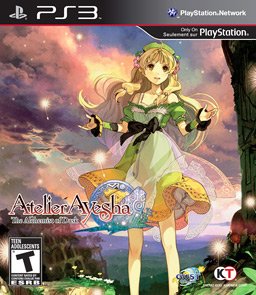A Walk On The Pharmaceutical Side
The Atelier series has always been more of a marginal franchise compared to the larger, more established JRPG properties like the mighty Final Fantasy or even Namco’s Tales series. Despite that smaller niche within a niche, Gust has managed to crank out 14 of these games since 1997, and the latest one, Atelier Ayesha carries on the tradition, albeit in a world different from what long-time fans are accustomed.
A New Alchemist Approaches
The Atelier series has always taken its name from the concept of an artisan at work in a workshop. In this case, the artisan is an alchemist, wandering the world, gathering ingredients and then returning to the workshop to synthesize everything from bread to new weapons. While most of the games in this series usually take place in the well established worlds of Salburg, Gramnad, Iris or Arland, Ayesha moves on to a new, self-contained world. Ayesha—pronounced “Ai-yee-sha”—is an alchemist in search of her sister, who was spirited away a few years earlier while visiting ancient ruins near their home. The arrival of an older, knowledgeable, mysterious stranger, and the brief reappearance of Ayesha’s sister in ghostly form kick off an adventure across the land, as Ayesha uses alchemy to try and bring her sister back.
As is Atelier tradition, Ayesha takes the refreshing approach of having no antagonist. Yup, that’s right, there’s no evil villain or ancient evil that needs defeating here. Instead, a mysterious phenomenon needs to be understood, and Ayesha’s herb gathering, turn-based battling journey with friends is all about solving a mystery, not beating a bad guy. As is JRPG tradition, there are random encounters with monsters, but these creatures aren’t in the service of some greater arch villain bent on world destruction/domination. Instead, Ayesha’s journey is filled with meeting new, interesting and often friendly people, who help her to grow as an alchemist and a person. She often does the same in turn, providing alchemical assistance or simple friendship with dramatic, positive results. For most RPG veterans, this is quite a change, but if offers a novel departure from established tropes. That’s not to say that everything is a win with this change; Ayesha’s characterization is a “dumb blonde” cliché, and she often blunders her way through many situations, with her cluelessness being uncomfortably used as an endearing trait. As with previous games, the majority of the cast is female and also fall into many frilly stereotypes, so there’s a definite otaku sensibility uncomfortably co-existing with the more interesting divergences from usual RPG story conventions.
On the technical side of things, it’s obvious from the get-go that this is a budget title. Gust does not have the resources of Square Enix—or even Atlus—and it shows in the modest production values of the game. No motion capture is on show here, and the environments are sparse, with simple textures that give the game the feel of an up-rezzed PS2 JRPG. Character models fare a little better, showing off where the brunt of the art budget went with some detailed character designs that actually hold up to the frequent close ups used for in-game cut scenes. On the other hand, even with lightly populated towns and dungeons, the game can struggle to keep the frame rate up. Even with populations nowhere near as heavy as the dungeons and towns of Dragon Age or Skyrim, the draw in distance for NPCs can be very short, showing a real lack of optimization in the game.
Sound is a mixed bag, erring more on the flat. The music is probably the best thing about the game, with that unique, bouncy, irritatingly infectious quality for drilling into your brain that only J-Pop style tunes carry. The voice acting is at best flat, and at worst awful, occurring only for the most important cut scenes, a far cry from the constant chatter of the critically acclaimed, but modestly budgeted Persona series by Atlus. The audio effects aren’t particularly impressive either, never taking advantage of multi-speaker set ups or even subwoofers. This is clearly a game where the effort went into the game design, not presentation.
Mixing Your Way To Victory
The Atelier series is based on two primary mechanics; the traditional turn-based JRPG battle system, and a very elaborate alchemy system that leaves the Persona demon fusion system eating dust in its wake. The interesting thing about Atelier is that, like the upcoming Final Fantasy XIII: Lightning Returns, players are always keeping an eye on the clock. In this case, Ayesha is warned very early on that her sister only has about three years before her ghostly condition becomes irreversible. This means that typical RPG strategies like grinding up levels, or even just taking on every side-available have to be tempered with some careful judgement. Most activities in the game take time, including traveling to different regions, gathering up raw components for alchemy, and of course, alchemizing itself. This adds a sense of tension and economy the game would otherwise lack since it doesn’t have the urgency of a villain egging things on, and forces players to brush up on their time management to do what they can efficiently.
The combat itself is standard fare for a last generation JRPG in that it is still adamantly turn-based which will be some welcome novelty for genre fans getting burned out on the recent emphasis for real time combat. One wrinkle added is that two separate meters build up for each character, one allowing for “support actions” like follow up attacks and protective maneuvers, while the other meter is for super attacks. Both meters fill as characters take action or damage, although support actions must executed during the animation of another character in order to take effect. So, for example, while Ayesha is lobbing one of her alchemized bombs, there’s a window of opportunity for a few seconds to hit one of the face buttons and have another character follow up with a standard attack, move around for a rear attack and damage bonus, or even move in to take a blow on Ayesha’s behalf. It’s actually a nice little touch that keeps players on their toes during combat.
Alchemy, on the other hand, is a different, complicated beast. Atelier Ayesha is a very systems driven game, and it shows in this central mechanic. It’s quite feasible to ignore the nuances of the system and just keep things basic; gathering required ingredients and pushing a single button to randomly mix things. But for those players willing to invest in the system, there’s an enormous complexity at play. Individual components have their stats and properties, and Ayesha’s alchemy skills can selectively boost certain effects or change conditions during the process. Tinkering with these interactions can mean the difference between a healing potion that heals for a small amount, and the same potion healing completely and automatically kicking in when HP falls below a certain point.
Looking at Atelier Ayesha as an overall package, the typical JRPG fan is going to come away thinking, “This is not bad, but not great.” There are cons that balance off the pros, so it’s a matter of where specific tastes in JRPGs lie. For people that focus mostly on systems, the pull of the tweaked, turn based combat and the elaborate synthesis system is going to devour hours of playtime. There’s a sense of satisfaction in understanding the interactions and finally cooking up a killer bomb or accessory to bring into combat. This carries over to the sense of exploration as new areas yield new ingredients, and special calendar events like the “Bazaar” bring up new, rare materials for sale if you can make it in time. For people that play JRPGs primarily for the story, many will find this game lacking with its less than stellar dialog and unsophisticated characters. Compared to the nuanced adolescent turmoil of Persona 4 Golden on the Vita, this game falls short.
However, beggars can’t be choosers, and those looking for another hit of PS3 JRPG gaming in the wake of Ni no Kuni don’t have many places to go. While Atelier Ayesha lacks both an adrenaline fueled plot and technical polish, it also has comprehensive systems and likable—if simplistic—characters. At $50, it’s not a bad buy for a starved JRPG fan that just wants a decent experience. But with games like Tales of Xillia and maybe Final Fantasy XIII: Lightning Returns as anticipated, bigger budget experiences, some may be inclined to wait for a price drop. This game will definitely scratch the JRPG itch, but not to a must have degree.





